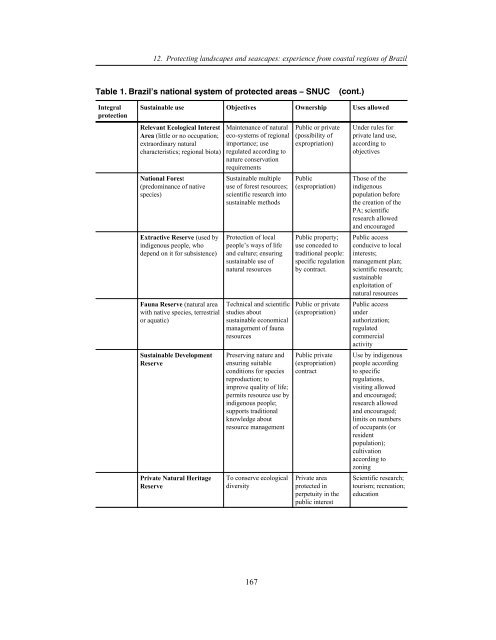The Protected Landscape Approach - Centre for Mediterranean ...
The Protected Landscape Approach - Centre for Mediterranean ...
The Protected Landscape Approach - Centre for Mediterranean ...
You also want an ePaper? Increase the reach of your titles
YUMPU automatically turns print PDFs into web optimized ePapers that Google loves.
12. Protecting landscapes and seascapes: experience from coastal regions of Brazil<br />
Table 1. Brazil’s national system of protected areas – SNUC<br />
(cont.)<br />
Integral<br />
protection<br />
Sustainable use Objectives Ownership Uses allowed<br />
Relevant Ecological Interest<br />
Area (little or no occupation;<br />
extraordinary natural<br />
characteristics; regional biota)<br />
National Forest<br />
(predominance of native<br />
species)<br />
Extractive Reserve (used by<br />
indigenous people, who<br />
depend on it <strong>for</strong> subsistence)<br />
Fauna Reserve (natural area<br />
with native species, terrestrial<br />
or aquatic)<br />
Sustainable Development<br />
Reserve<br />
Private Natural Heritage<br />
Reserve<br />
Maintenance of natural<br />
eco-systems of regional<br />
importance; use<br />
regulated according to<br />
nature conservation<br />
requirements<br />
Sustainable multiple<br />
use of <strong>for</strong>est resources;<br />
scientific research into<br />
sustainable methods<br />
Protection of local<br />
people’s ways of life<br />
and culture; ensuring<br />
sustainable use of<br />
natural resources<br />
Technical and scientific<br />
studies about<br />
sustainable economical<br />
management of fauna<br />
resources<br />
Preserving nature and<br />
ensuring suitable<br />
conditions <strong>for</strong> species<br />
reproduction; to<br />
improve quality of life;<br />
permits resource use by<br />
indigenous people;<br />
supports traditional<br />
knowledge about<br />
resource management<br />
To conserve ecological<br />
diversity<br />
Public or private<br />
(possibility of<br />
expropriation)<br />
Public<br />
(expropriation)<br />
Public property;<br />
use conceded to<br />
traditional people:<br />
specific regulation<br />
by contract.<br />
Public or private<br />
(expropriation)<br />
Public private<br />
(expropriation)<br />
contract<br />
Private area<br />
protected in<br />
perpetuity in the<br />
public interest<br />
Under rules <strong>for</strong><br />
private land use,<br />
according to<br />
objectives<br />
Those of the<br />
indigenous<br />
population be<strong>for</strong>e<br />
the creation of the<br />
PA; scientific<br />
research allowed<br />
and encouraged<br />
Public access<br />
conducive to local<br />
interests;<br />
management plan;<br />
scientific research;<br />
sustainable<br />
exploitation of<br />
natural resources<br />
Public access<br />
under<br />
authorization;<br />
regulated<br />
commercial<br />
activity<br />
Use by indigenous<br />
people according<br />
to specific<br />
regulations,<br />
visiting allowed<br />
and encouraged;<br />
research allowed<br />
and encouraged;<br />
limits on numbers<br />
of occupants (or<br />
resident<br />
population);<br />
cultivation<br />
according to<br />
zoning<br />
Scientific research;<br />
tourism; recreation;<br />
education<br />
167

















